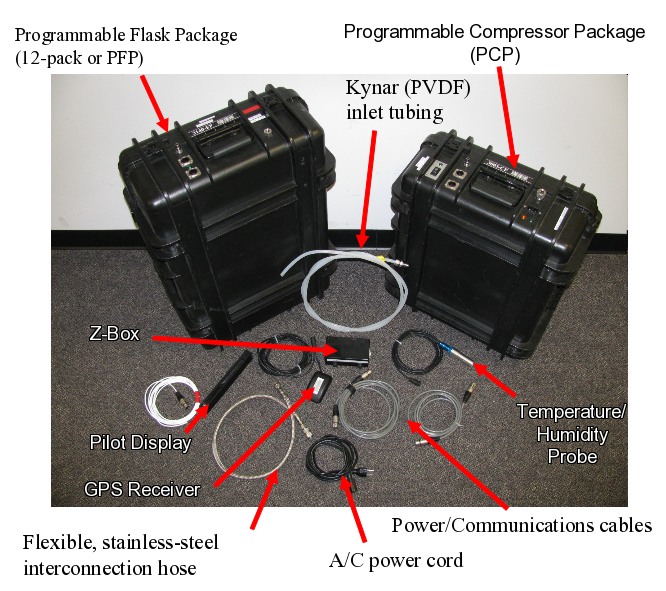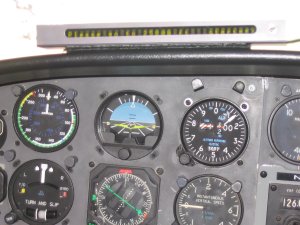Sampling
The backbone of the aircraft network is the programmable 12-flask sampling system used to collect air samples at different altitudes. The system consists of a programmable compressor package (PCP) and a programmable flask package (12-pack or PFP).

Programmable Compressor Package (PCP):
The PCP includes two pumps that have been plumbed in series. The first-stage pump (KNF Model N828 with aluminum head and Viton diaphragm) is designed to ensure flow rates of at least 5L/min at 8000 meters above sea level (masl) and 15L/min at sea level. The second-stage pump (KNF Model N814 with aluminum head and Viton diaphragm) is designed to ensure that samples can be reliably compressed to 40 psia at altitudes up to 8000masl. The PCP is powered by a nickel-metal hydride (NiMH) rechargeable battery, which enables the pumps to fill up to four 12-packs (48 flasks) before recharging.

Programmable Flask Package (12-Pack or PFP):
The 12-pack is composed of twelve, 0.7L borosilicate glass flasks, a stainless-steel manifold system, glass valves sealed with Teflon O-rings, and a data logging and control system. The 7.5 cm diameter cylindrical flasks have glass valves at each end and are stacked in two rows of six. A flexible stainless-steel manifold connects all of the flasks in parallel on the inlet side of the flasks. The valves at both ends of the flasks can be opened and closed with motor-controlled valves. The valve mechanism is made of a glass rod and Teflon o-ring, which seals against a beveled glass valve seat when inserted into the valve body. The data logging and control system in the 12-pack provide the interface for controlling the sampling valves, as well as for storing a sampling plan and target flush volume and fill pressure for the samples. Actual sample flush volumes and fill pressures during sampling are recorded by the data logger, along with system status and a time stamp. When GPS position, ambient temperature, pressure and relative humidity are available from external sensors, these values are also recorded by the data logger at 10-second intervals.
Sampling Routine:
A typical sampling site has one PCP and one or more 12-packs that are pre-programmed with a site-specific sampling plan that includes target altitudes for each sample. Before a typical flight the system is first leak tested by flushing the internal flask manifold and then pressurizing to 40 psia. After 10 seconds the pressure is checked to ensure that there are no significant leaks in the tubing connecting the PCP and the 12-pack or within the manifold connecting all the individual flasks.

The PCP is also connected to a Pilot Display, an alphanumeric LED display and toggle switch, which communicates target sampling altitudes to the pilot. Once the pilot reaches each altitude, s/he activates the toggle switch during level flight and waits until the sample is finished. For each sample, the inlet line and internal manifold are first flushed with about 5 liters of ambient air. The valves on both ends of the selected flask are then opened and the flask is flushed with about 10 more liters of ambient air to displace the dry, low CO2 (~330 umol/mol) fill gas with which the flasks are shipped. The sample flush air is measured by a mass flow meter to ensure that a sufficient volume passes through the manifold and flask before the downstream valve is closed and pressurization begins. Typically, pressurization of a flask takes 10 seconds, and is monitored by an internal absolute pressure sensor. Assuming a flow rate of 5L/min, which might be observed at 8000m in a pressurized plane, and perfect mixing throughout the flask volume, 99% (5 e-folding times) of the 0.35L volume (at ~500 Pa) will flushed in the last 20 seconds of the flush cycle. An additional ~1.55L of sample will be added once the downstream flask valve has been closed making the total sampling time under 40 seconds to collect 99.9% of the sample. If it is assumed that flow the flask is better represented by a plug flow than a perfectly mixed volume (Neff et al. [in prep]), we expect a significant decrease in the time needed to take a sample.
